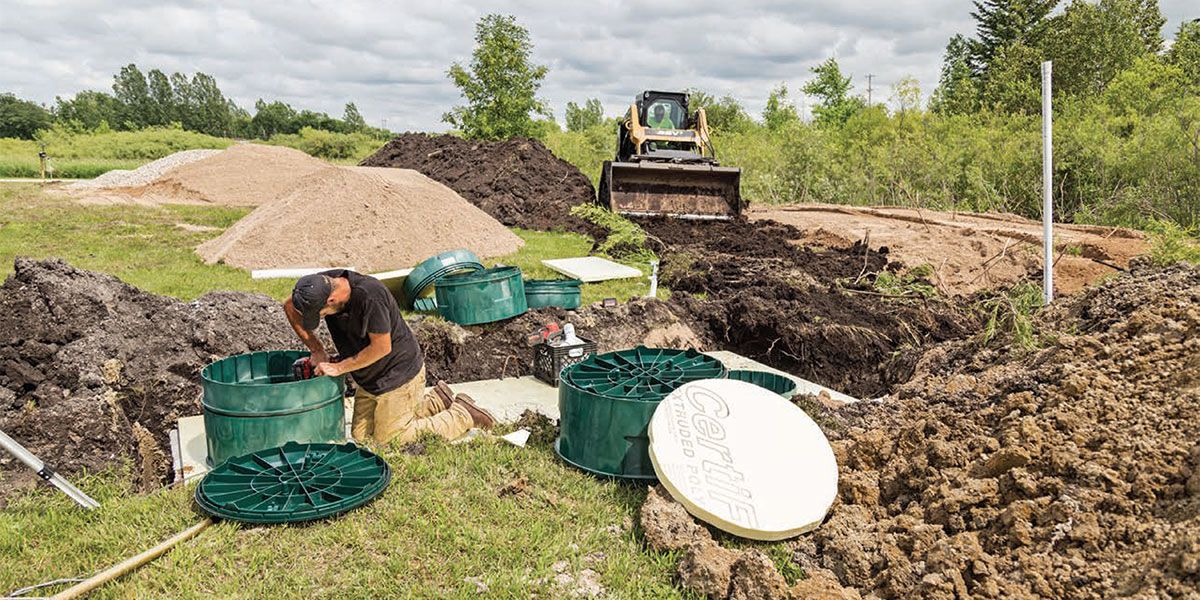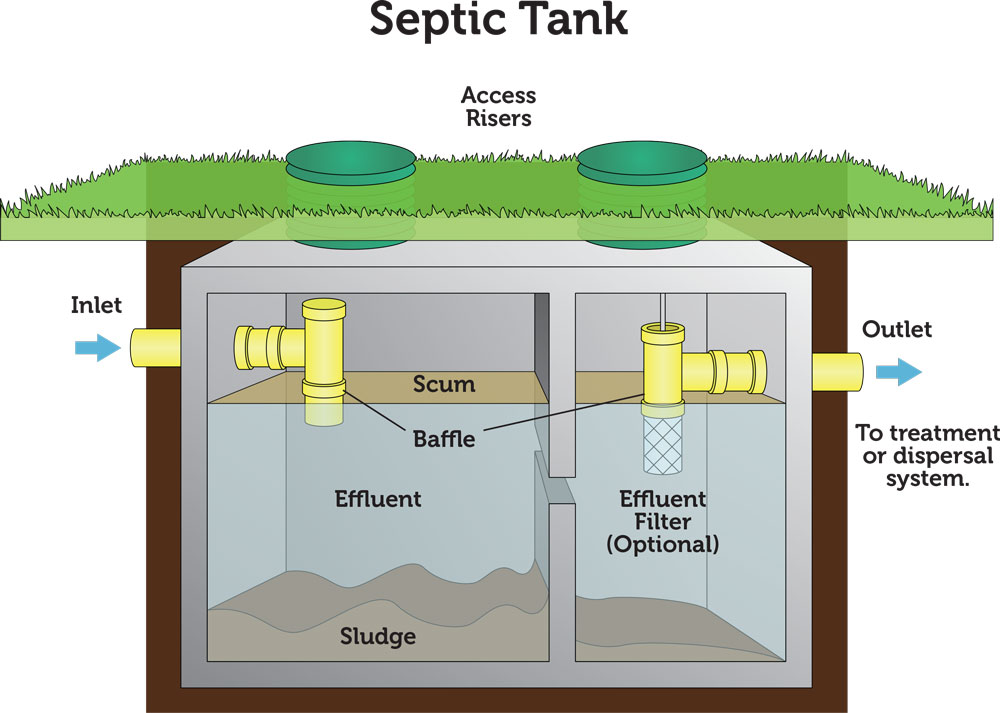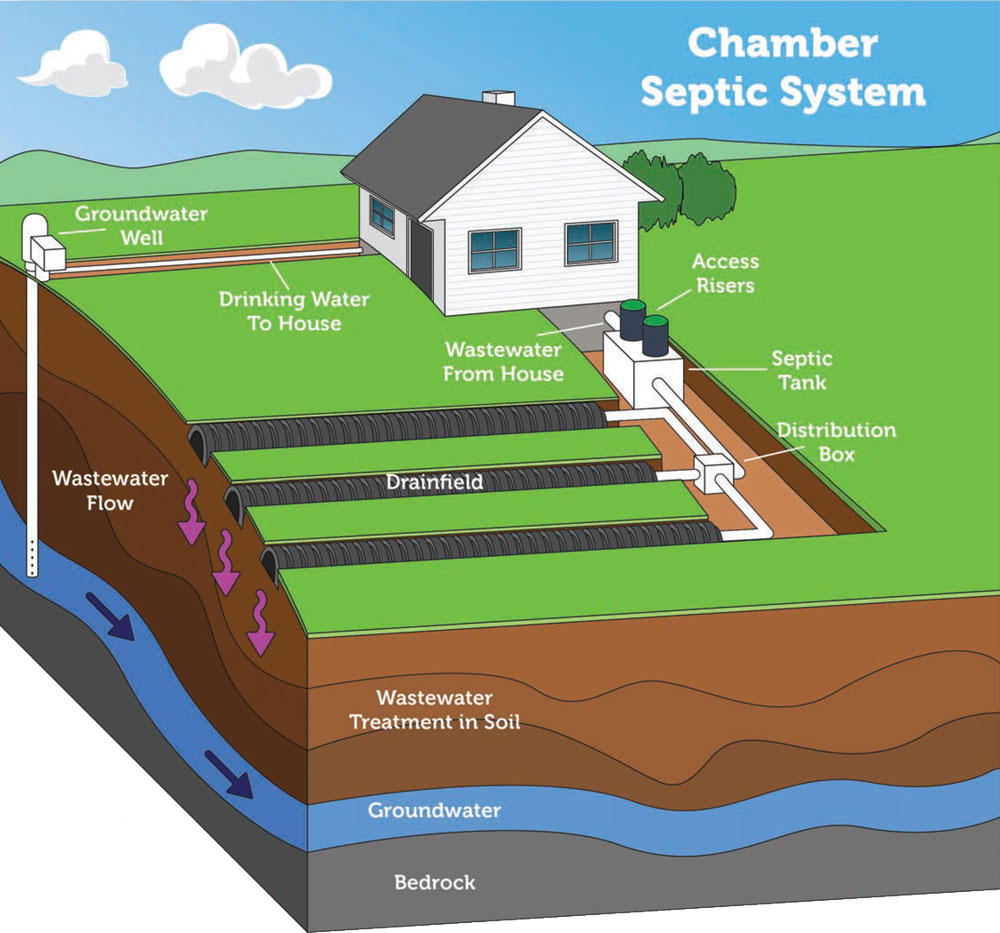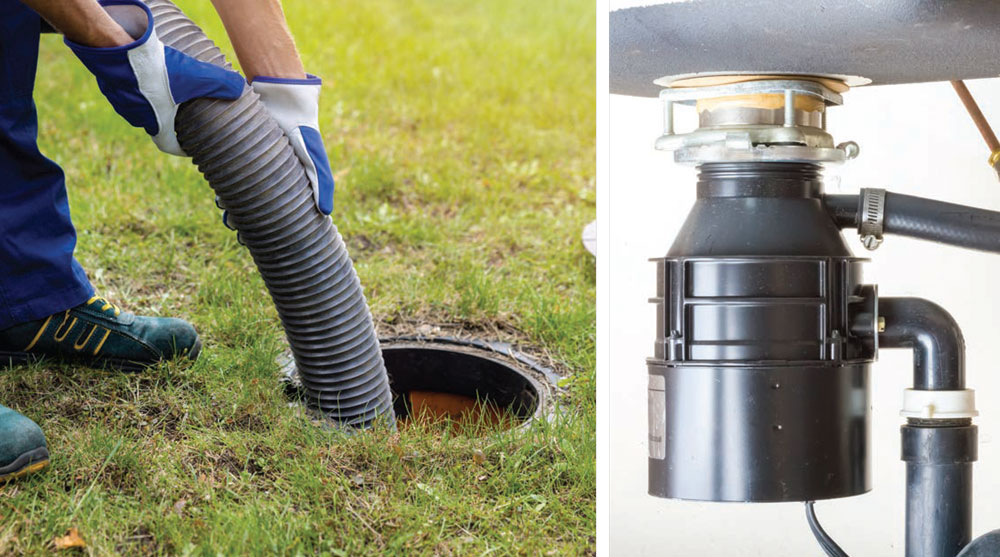Septic Systems 101

AVOID COSTLY MISTAKES WITH CARE & MAINTENANCE
Septic system, sewage disposal system, country plumbing: these titles conjure images of mysterious superstitions and a host of misinformation that suggest maintaining a home in the country is daunting. Actually, septic systems are simple and effective. All it takes is a bit of knowledge and a punctual routine of minimal maintenance.
 Please note: The number of compartments in a septic tank vary by state and region.
Please note: The number of compartments in a septic tank vary by state and region.
GRAPHIC: ENVIRONMENTAL PROTECTION AGENCY
How septic systems work
A septic system is designed to take used water from a home’s kitchen, baths and laundry outside and filter it so the water can drain back into the ground. Using gravity, the wastewater runs through the home’s pipes into a holding tank where bacteria aid in the breakdown of debris or solids. The solids settle to the bottom of the tank, the fats and oils rise to the top and the filtered water layer in the middle runs through pipes into the drain field. Over time, the solids in the septic tank fill and must be pumped out by a septic tank contractor.
 Please note: Septic systems vary. Diagram is not to scale.
Please note: Septic systems vary. Diagram is not to scale.
GRAPHIC: ENVIRONMENTAL PROTECTION AGENCY
A drain field is an area of the yard that is near the septic tank. It is comprised of pipes with holes in them. The pipes are buried in gravel then covered with a layer of dirt. On top of the dirt, grass grows so it appears to be a nice green lawn. Underneath, your plumbing system is hard at work.
What are the basic guidelines?
Scott McLaughlin of Cut Rate Septic Service suggests, “the first thing is to have an onsite soil evaluation, otherwise known as a perc [percolations] test, performed by a qualified soil evaluator to determine if your property is able to support a septic system and determine the appropriate size of the septic system your soil will support.” Once you get the test results, your local Department of Health will determine the system requirements to support the proper drainage of your septic system. From there, your system is designed specifically for your lot and home, taking into consideration tank size, distribution box or boxes, drain field and pipes. Construction permits are required. Always hire a qualified and licensed septic system installer who will have the final system inspected and approved by the Health Department.
How do you maintain a healthy system?
Septic systems are easy to maintain. “Treat your septic system as you would a conventional sewer system, with just a few caveats,” McLaughlin said, breaking it down to a few basic rules:
- Avoid flushing plastic or hard solid objects into your septic system (such as feminine hygiene products) and avoid flushing dense paper products such as baby wipes, “flushable” wipes, paper towels or heavy-duty toilet paper. Single-ply toilet paper is easiest for your septic system to break down. Two-ply toilet paper is usually acceptable but avoid three-ply paper.
- Avoid the use of “anti-microbial” soaps, bleaches and harsh detergents — these harm or destroy the microbes in your septic system. Although these products may eliminate germs and bacteria inside your house and on your body, they are harmful to the essential bacteria and microbes that break down solids inside your septic system. Also, minimize citrus and acidic foods (such as tomato sauce) from being washed down the drain. Your septic system easily handles small amounts of these food products, but excessive amounts of acidic foods can diminish essential bacteria levels.
- If your house has a swimming pool, the high levels of chlorine absorbed by your swimwear risks damaging the necessary microbes if they are washed using a machine that drains into your septic tank. You may consider having those garments and towels laundered at a laundromat.
- It’s important to have your septic system pumped at least every three to five years depending on usage level. Systems that have not been pumped in the last five years tend to have heavier solids that compact over time in the bottom of the tank. Removing compacted solids consumes technician time and increases the price of pumping your tank.
- Your septic system benefits from occasional dairy products (yogurt, milk, cheese) being poured down the drain. Bacteria and microbes thrive on dairy products and multiply quicker.
- Minimize the amount of grease being flushed into your septic system. Grease and particulates can clog pipes and septic lines.
- Be present and ask the technicians questions while they pump your septic system. The technicians will show you specifically what is going on with your system and what issues they observe. They will also provide recommendations to assist you in maintaining a healthy septic system. Once your system is clean, there should only be approximately 2-3 inches of liquid waste at the bottom of your tank to provide the needed bacteria and microbes necessary to multiply and aid in the function of your septic system.
- Empty a packet of baker’s yeast into your kitchen sink drain with warm water every 30-60 days. This helps maintain healthy and active microbes in your septic system to efficiently break down solids that can easily be pumped out during the servicing of your septic tank.
Can you have a garbage disposal?
Yes. “Most food products will be reduced into sizes easily removed by the septic pump hoses and may provide nutrients necessary to the bacteria and microbes in your septic system. Be cautious, as outlined earlier, to minimize the amount of citrus fruits and acidic foods,” McLaughlin notes.
Septic systems are simple and green. If homeowners follow a few guidelines, the septic system will provide reliable service. A side benefit of a septic system: it offers a healthy green lawn over the drain field — perfect space for a putting green, croquet or badminton game. ✦
country plumbing, drain field, percolations, Septic system, sewage disposal system, wastewater







